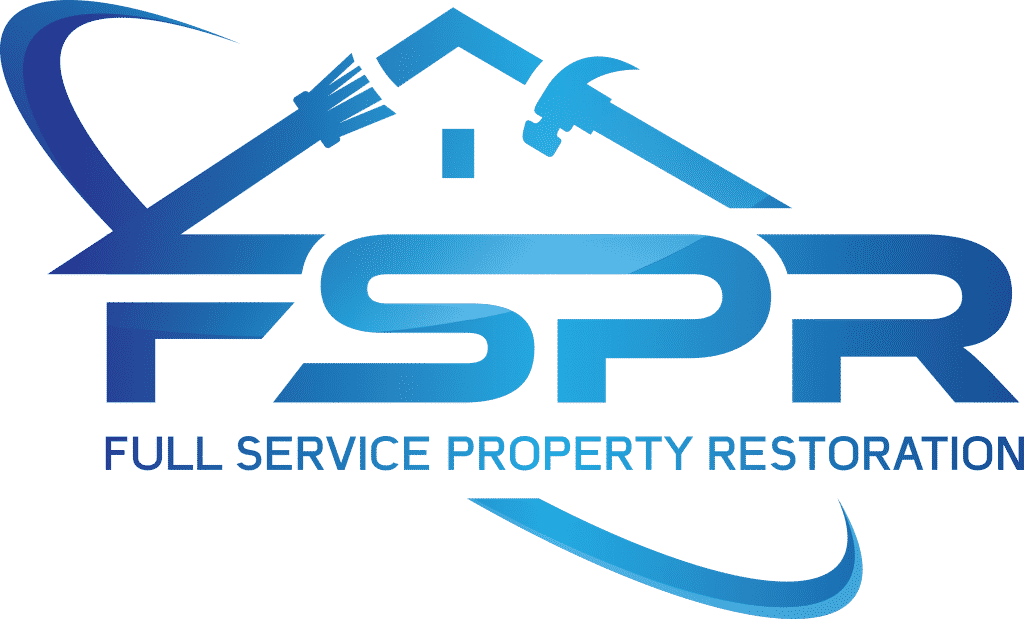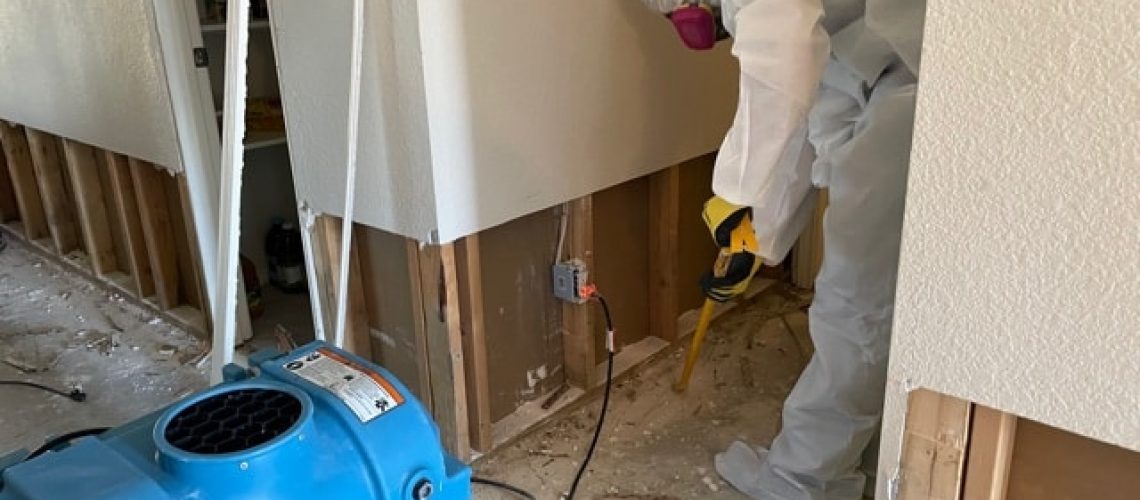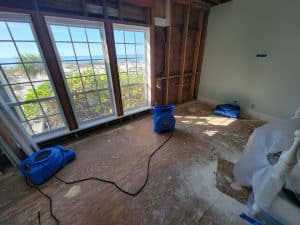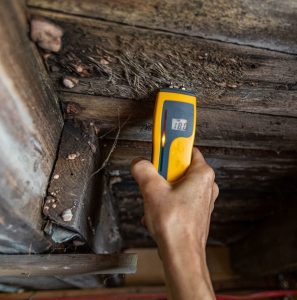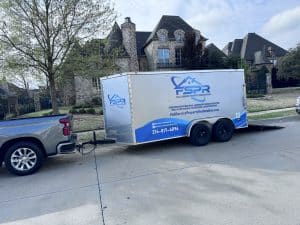At Full Service Property Restoration, one of the most common questions we get from customers is “If the water damage is cleaned up, will the mold stop growing?” It’s a great question—and one that deserves a clear answer.
Here’s the truth: Fixing water damage is an essential first step, but it doesn’t automatically mean mold growth will stop.
Let’s walk through why that is, what actually happens to mold after water damage, and what you need to do to truly eliminate the problem.
Key Takeaways
- Water damage cleanup is only the first step—mold can still grow afterward in the right condition.
- Mold can continue to grow inside porous materials, even when surfaces feel dry.
- Professional drying, moisture monitoring, and mold inspections are essential to stop mold for good.
- Managing humidity and indoor air quality helps prevent mold regrowth after cleanup.
- If mold has started growing, remediation is required to safely remove it and protect your health and home.
Understanding Mold and How It Grows
Before we dive into what happens after water damage cleanup, it helps to understand how mold behaves. Mold is a type of fungus that thrives in moist environments. It reproduces by releasing tiny spores into the air, and those spores are everywhere—inside your home, outside in the yard, and just about anywhere else you can think of.
All mold really needs to grow is:
- Moisture
- Organic material (like drywall, wood, carpet, or insulation)
- The right temperature (usually between 60–80°F)
If you’ve had water damage in your home from a burst pipe, a roof leak, storm flooding, or any other source, you’ve just created an ideal environment for mold to move in and spread.
How Quickly Can Mold Grow After Water Damage?
Mold doesn’t waste any time. Under the right conditions, it can start growing within 24 to 48 hours after water damage occurs.
That’s why we always stress how important it is to act fast when there’s been water intrusion. Every hour counts. The longer water sits, the more damage it causes, and the greater the chance that mold will become a serious issue.
So… Will Mold Stop Growing After the Water is Gone?
The short answer is- not necessarily.
While mold needs moisture to grow, once it takes hold in porous materials (like drywall or wood), it doesn’t just stop growing the moment things look dry.
Here are a few key reasons why:
1. Materials May Still Be Holding Moisture
Just because a surface looks dry doesn’t mean it is dry. Porous building materials can retain moisture deep within for days or even weeks. Mold can continue to grow within these materials even if the surface appears dry to the touch.
2. Mold Colonies May Already Be Established
If mold started growing during the water damage period, colonies may already be present. These colonies don’t disappear once the water is gone. They need to be physically removed or professionally remediated to eliminate the risk.
3. Humidity Levels Can Still Feed Mold
Even if the standing water is removed, high indoor humidity can still promote mold growth. Anything over 60% relative humidity indoors creates a favorable environment for spores to grow and spread.
4. Spores Can Remain Active
Mold spores are incredibly resilient. Even when dormant (like when the area dries out), they can “wake up” and start growing again if conditions become favorable—like during a humid summer or if there’s a small unnoticed leak.
What Needs to Happen to Truly Stop Mold Growth?
To really put a stop to mold after water damage, you need more than just water removal. Here’s what needs to happen:
Step 1: Professional Water Damage Mitigation
This includes more than just vacuuming up water. At Full Service Property Restoration, we use industrial-grade equipment to extract water, thoroughly dry the structure, and monitor moisture levels in walls, floors, and ceilings. Drying is a science, and we take it seriously.
Step 2: Moisture Detection and Monitoring
We use moisture meters and infrared cameras to find hidden moisture. Many areas that seem fine can actually be saturated below the surface. Monitoring these areas over several days ensures they dry completely, reducing the chance of mold taking hold later.
Step 3: Mold Inspection
If there’s any suspicion of mold or if the water has been sitting for more than 24–48 hours, a mold inspection service becomes necessary. This may involve surface sampling, air quality testing, or simply a thorough visual assessment by trained technicians.
Step 4: Mold Remediation (If Needed)
If mold is discovered, it needs to be professionally removed by a company like us. Mold remediation is a specialized process that involves:
- Containing the affected area
- Using HEPA-filtered air scrubbers
- Physically removing or cleaning affected materials
- Treating the space with anti-fungal or antimicrobial products
Step 5: Humidity and Air Quality Control
Once cleanup is done, managing the environment becomes key. Keeping indoor humidity below 50% and ensuring proper ventilation will help prevent future mold growth. A dehumidifier can be a great investment in damp or humid areas.
The Dangers of Ignoring Mold After Water Damage
Some homeowners assume that once the water is gone, their job is done. Unfortunately, ignoring mold can lead to bigger issues down the line, including:
- Health problems: Mold exposure can trigger respiratory issues, allergic reactions, and more, especially in children, seniors, and people with asthma or compromised immune systems.
- Structural damage: Over time, mold can break down wood, drywall, and other materials, leading to costly repairs.
- Lingering odors: Mold has a musty smell that can linger if it’s not addressed.
- Decreased property value: Unresolved mold issues can lower home value and even complicate future real estate transactions.
The bottom line? Water damage may be the start of the issue, but mold is often the lingering threat.
Common Signs of Mold After Water Damage
Even after water cleanup, keep an eye out for these signs of mold:
- Musty or earthy odors
- Discoloration or staining on walls, ceilings, or floors
- Peeling paint or wallpaper
- Allergy-like symptoms (sneezing, coughing, itchy eyes) indoors
- Visible fuzzy patches, usually black, green, white, or gray
If you notice any of these signs, even if it is weeks or months later, it’s worth having a professional come check it out.
Why Work With Full Service Property Restoration?
At Full Service Property Restoration, we specialize in comprehensive water damage cleanup and mold prevention or removal/remediation. Our team is trained to handle the full scope of what water damage can do to your home or business—not just the immediate mess, but the hidden risks that come after.
We understand how stressful this process can be. That’s why we’re here to guide you through it, step by step. From advanced drying and dehumidification to mold remediation, we’re committed to helping you protect your property and your peace of mind.
Whether it’s a burst pipe, a leaking roof, or a flooded basement, we’ve seen it all—and we know how to fix it.
Final Thoughts
Water damage doesn’t end when the water is gone. and mold is often the part you can’t see until it becomes a problem. The good news? With the right team on your side, it’s completely manageable.
If you’ve experienced water damage, don’t wait. The sooner you act, the better your chances of avoiding mold altogether. And if you’re already dealing with mold concerns after a water issue, we’re here to help with proven solutions and honest guidance.
Contact Full Service Property Restoration today to schedule your service, get expert advice, and take the next step toward a clean, safe, and mold-free home.
